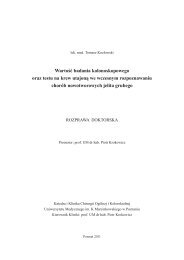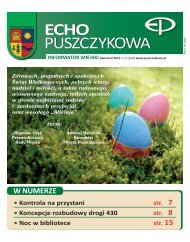MILITARY PHARMACY AND MEDICINE
MILITARY PHARMACY AND MEDICINE
MILITARY PHARMACY AND MEDICINE
You also want an ePaper? Increase the reach of your titles
YUMPU automatically turns print PDFs into web optimized ePapers that Google loves.
© Military Pharmacy and Medicine • 2012 • 4 • 6 – 16week (e.g. salmon, herring, mackerel) provide thebody with these fatty acids in amounts sufficientnot only for needs of the organs of vision, but alsoof the entire system.Polyunsaturated fatty acids of the omega-6 series(PUFA-ω6), also essential for human body, areusually consumed in high amounts, as they arepresent in commonly used vegetable oils – e.g.linoleic acid (C18:2ω6 or C18:2n-6, which is thefirst acid in the omega-6 series) is abundant ingrape seed oil and sunflower oil (63–66%), aswell as in corn oil and soybean oil (55–56%);other oils have much lower contents of linoleicacid (rape oil, linen oil, olive oil — 10–21%). Incase of PUFA-ω3, the case is more difficult, asEPA and DHA are virtually absent in vegetableoils, while alpha-linolenic acid (ALA; C18:3ω3or C18:3n-3, being the first acid in the omega-3series) is present only in moderate amounts inrape oil and soybean oil (7–11%), as well as inlarge amounts (!) in linen oil (55%) [3] . For thesake of comparison, the overall PUFA-ω3 (ALA,EPA and DHA) content in fish oil (herring oil)is > 28%, while the linoleic acid (ω6) contentis slightly above 12%. Cold-pressed linen oil isavailable in an increasingly broad commercialoffer. Although not everyone finds it tasty, linenoil is a recommended addition to the diet, notonly of AMD patients. However, one shouldremember that conversion of ALA into EPA orDHA in human body is very low, and thereforethe supply of ALA may not substitute for directsupply of DHA and DPA (which are abundantin marine fish).species, highest amounts of DHA and EPA (expressed overall in g/100 g of weight) canbe found in Atlantic salmon (> 2; farm-raised and wild caught) and herring (mainlyAtlantic herring ≈ 2), then in mackerel and tuna (1.2–1.5); the popular canned tunacontains much smaller amounts (0,3–0,8); less DHA + EPA can be found in halibut andcod (0,2–0,6), while a higher content can be found in trout (farm-raised and wild caught)(≈ 1). As far as DHA is concerned, the highest content can be found in salmon, herringand tuna (excluding canned tuna in brine) and trout. Although fish contain particularlyhigh amounts of EPA, DHA and DPA, other natural sources of these acids are human milk,farm-grown marine algae, marine mammals and krill; as mentioned in the article, somevegetable oils, including linen oil, do not contain EPA and DHA, although they may containlarge amounts of alpha-linolenic acid (PUFA-ω3).[3] The percentage composition of selected fatty acids in the linen oil is as follows:alpha-linonenic acid (18:3ω3) – 54.5%, oleic acid (18:1ω9) – 19.7%, linoleic acid (18:2ω6)– 16.2%, palmitic acid (16:0) – 5.1%, stearic acid (18:0) – 3.7%, other acids – 0,8%. Thelinen oil contains no EPA or DHA. The ω6/ω3 ratio is 0.3. For the sake of comparison, thepercentage composition of fish oil (herring oil) is as follows: eicosapentaenoic acid (EPA;20:5ω3) – 17.2%, palmitic acid (16:0) – 13.9%, palmitoleic acid (16:1ω7) – 13.1%,linoleic acid (18:2ω6) – 12.4%, oleic acid (cis-Δ 9 -octadecenoic acid; 18:1ω9) – 11.6%,docosahexaenoic acid (DHA; 22:6ω3) – 9%, myristic acid (tetradecanoic acid; 14:0) – 7.4%,stearic acid (octadecanoic acid; 18:0) – 2.7%, linolenic acid (18:3ω3) – 2.1%, elaidicacid (trans-Δ 9 -octadecenoic acid; 18:1ω9) – 2%, gadoleic acid (cis-Δ 11 -icosenoic acid;20:1ω9) – 1.5%; ω6/ω3 ratio = 0.4.Review articleModern diet, particularly the Western diet, isrich in the fatty acids of the omega-6 series, andthe ratio of these acids to the omega-3 (ω3) acidsmay be as high as 20:1, or even higher! The properratio should be about 4:1, with a trend towardsbalanced supply of both types of acids; this leadsto the natural need for omega-3 acids supplementation(EPA, DHA, ALA and docosapentaenoicacid — DPA-ω3); in case of AMD, DHA is of thehighest importance. Despite its disadvantages(easy peroxidation and fragmentation), DHAis absolutely necessary for regeneration of photoreceptorouter segments worn off in the processof vision as well as to maintain appropriateplasticity/susceptibility of the cell membrane inrods and cones. In addition, EPA and DHA aresubstrates for production of anti-inflammatoryresolvins and maresins (the latter are formedonly from DHA) which are very important forthe photoreceptors-RPE cells complex. DHA isalso a substrate for production of neuroprotectin,which is involved in many protective, antiinflammatoryand cytoprotective mechanisms[8]. More information on the pros and cons ofDHA may be found in a recent article by thesame author [3].The advantage of thus-profiled diet (as mentionedabove) is that the elements valuable, among others,for intraocular metabolism, are deliveredto the organism in natural, purely physiologicalfashion, which guarantees optimum gastrointestinalabsorption and transport to target tissues/cells as long as a diversified and well-balanceddiet is maintained. One should remember thatthese microelements, being so important notonly for AMD patients, are absorbed into circulationfrom the gastrointestinal tract in a diversemanner, as they represent different types ofchemical structures and molecular mass ranges.Well-balanced diet containing diverse proteins,carbohydrates and all types of fats (long – andshort-chain, saturated and unsaturated) establisheswithin the stomach and the intestines anatural chemical environment that favors passiveor active absorption of microelements suppliedwith food.This natural, physiological situation is very muchdifferent from situation taking place in the stomach(oftentimes an empty one) after ingestion ofdietary supplement tablets/capsules followed bya glass of water! Microelements contained in the6 http://military.isl-journals.com
















